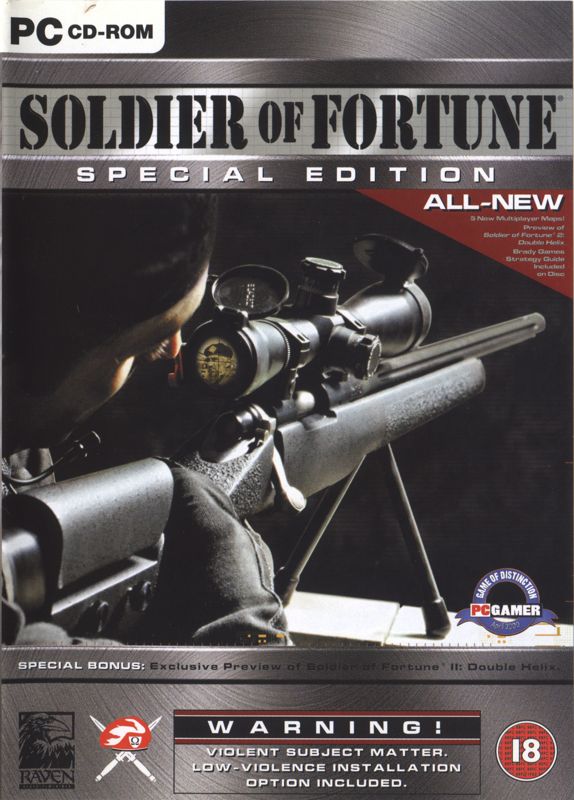Soldier of Fortune, a first-person shooter developed by Raven Software and published by Activision, made its debut in 2000 and quickly garnered attention for its realistic and visceral depiction of modern warfare.
Set against the backdrop of a globe-trotting adventure, the game places players in the boots of John Mullins, a mercenary working for a covert anti-terrorist organization known as “The Shop.” Tasked with thwarting a nuclear threat, Mullins navigates through a series of intense and perilous missions that span various international locations.
Upon its release, “Soldier of Fortune” was both lauded and criticized for its graphic content, which pushed the boundaries of what was considered acceptable in video games at the time. The game’s use of the GHOUL damage model allowed for unprecedented levels of anatomical accuracy in combat, resulting in a controversial yet undeniably immersive experience.
This groundbreaking approach to in-game violence set “Soldier of Fortune” apart from its contemporaries, making it a polarizing yet influential title in the history of first-person shooters.
This review will delve into the various aspects that define “Soldier of Fortune,” examining its gameplay mechanics, graphical fidelity, sound design, and narrative elements. Through a detailed analysis, we aim to provide a comprehensive overview of what makes this game a memorable, albeit contentious, entry in the genre.
Whether you’re a veteran player revisiting a classic or a newcomer curious about what this title has to offer, this review will offer insights into the enduring legacy of Soldier of Fortune.
Combat System
Soldier of Fortune excels in delivering a visceral and dynamic combat experience that keeps players on the edge of their seats. The game’s combat system is both intuitive and challenging, offering a significant degree of realism that sets it apart from other first-person shooters of its time.
The mechanics are designed to mimic real-life combat scenarios, with a focus on strategic positioning and quick reflexes. Players must constantly be aware of their surroundings, utilizing cover and taking advantage of the game’s destructible environments to gain the upper hand.
One of the standout features of the combat system is its hit detection and damage modeling. The game employs a detailed locational damage system, meaning that where you hit an enemy significantly impacts the outcome. Shots to different body parts yield varied results, adding a layer of tactical depth. This encourages players to aim carefully rather than resorting to spray-and-pray tactics.
Weapons and Equipment
The arsenal available in “Soldier of Fortune” is both extensive and diverse, catering to a variety of playstyles. From standard-issue pistols and assault rifles to more exotic weaponry like flamethrowers and grenade launchers, the game ensures that players always have the right tool for the job. Each weapon feels unique, with distinct firing patterns, recoil effects, and reload times that must be mastered for effective use.
Customization is another key aspect, as players can often modify their weapons with attachments such as scopes, silencers, and extended magazines. This allows for a tailored approach to combat, whether you prefer silent takedowns or all-out assaults. Additionally, the game includes a variety of gadgets and equipment, like night-vision goggles and body armor, which further enhance the tactical options available to players.
Level Design
The level design in “Soldier of Fortune” is meticulously crafted to provide a balanced mix of open combat arenas and tight, claustrophobic corridors. Each level is designed to challenge players in different ways, from wide-open battlefields that require strategic use of cover to narrow hallways that demand quick reflexes and precision shooting.
Interactive environments play a crucial role in the level design, offering multiple pathways and opportunities for creative problem-solving. Whether it’s finding a hidden route to flank enemies or using environmental hazards to your advantage, the game rewards exploration and tactical thinking.
The levels are also populated with a variety of enemy types, each with their behaviors and tactics, ensuring that players must adapt their strategies to succeed.
Overall, the gameplay mechanics of “Soldier of Fortune” are robust and engaging, providing a deeply satisfying experience that combines strategic depth with fast-paced action.
Graphics and Sound
When it comes to the sensory experience of “Soldier of Fortune,” the game offers a mixed bag of visuals and audio elements that work together to create a compelling atmosphere, albeit with some rough edges.
“Soldier of Fortune” was released during a time when 3D graphics were rapidly evolving, and it shows in the game’s visual presentation. The environments are richly detailed, bringing a gritty realism to the war zones and urban landscapes that players must navigate. The textures, while not state-of-the-art by today’s standards, were quite impressive for the game’s release period, contributing to an immersive experience.
Character models are well-designed, with a noticeable effort put into making enemies and NPCs look distinct and varied. However, some animations can appear stiff, particularly during more complex actions like climbing or reloading. The game’s use of lighting and shadows adds a layer of depth, enhancing the atmosphere during night missions or in poorly lit interiors.
Special mention must be made of the game’s gore system. “Soldier of Fortune” gained notoriety for its graphic depictions of violence, utilizing the GHOUL engine to allow for realistic dismemberment and injury effects. This feature, while controversial, sets the game apart and adds a visceral intensity to firefights.
The sound design in “Soldier of Fortune” is another area where the game excels. Gunfire, explosions, and the sounds of footsteps are all distinct and contribute to the realism of the combat experience. The developers paid close attention to the acoustics, ensuring that sounds change realistically based on the environment, such as echoes in hallways or muffled noises through walls.
Environmental sounds also play a crucial role. The ambient noise of distant battles, the rustle of leaves, and the hum of machinery help to immerse players in the game world. However, there are occasional inconsistencies, such as repetitive sound loops or abrupt audio cutoffs, that can momentarily break the immersion.
The music score of “Soldier of Fortune” complements its intense gameplay with an equally gripping soundtrack. The music dynamically shifts to match the on-screen action, ramping up during firefights and dialing back during moments of exploration or tension-building. This adaptive approach keeps players engaged and heightens the emotional stakes of each mission.
The score itself is a mix of orchestral and electronic elements, designed to evoke a sense of urgency and danger. While the tracks are generally well-composed, there is a certain repetitiveness that can become noticeable during extended play sessions. Nevertheless, the music serves its purpose well, enhancing the overall atmosphere of the game.
In summary, “Soldier of Fortune” delivers a robust audiovisual experience that, despite some minor flaws, effectively immerses players in its gritty world of mercenary combat. The combination of detailed graphics, impactful sound effects, and a dynamic music score ensures that the game leaves a lasting impression.
Story and Characters
“Soldier of Fortune” is set against a backdrop of international terrorism and covert operations, plunging players into a gritty narrative that mirrors the complex geopolitical landscape of the late 1990s. The story follows John Mullins, a mercenary working for a secret anti-terrorist organization known as “The Shop.” As the protagonist, Mullins is tasked with preventing a global catastrophe by tracking down a stolen cache of nuclear weapons.
Plot Overview
The plot of “Soldier of Fortune” unfolds through a series of high-stakes missions that take Mullins to various parts of the world, from war-torn urban environments to clandestine underground bunkers. Each mission is intricately designed to escalate the tension and immerse players in a narrative that feels both urgent and consequential. The storyline is driven by a mix of espionage, tactical warfare, and moral ambiguity, reflecting the darker aspects of modern warfare and the shadowy world of international mercenaries.
One of the game’s strengths lies in its ability to weave a cohesive narrative that keeps players engaged from start to finish. The story is peppered with plot twists and revelations that add depth to the otherwise straightforward premise of stopping a global threat. The pacing is well-balanced, with moments of intense action interspersed with quieter, more contemplative sequences that allow for character development and story progression.
Character Development
John Mullins is a well-crafted protagonist, portrayed not just as a hardened soldier but also as a complex individual grappling with the moral implications of his actions. His character is fleshed out through in-game dialogues, cutscenes, and mission briefings that reveal his motivations, fears, and ethical dilemmas. This attention to character development adds a layer of emotional depth to the game, making Mullins more than just a generic action hero.
Supporting characters, though not as deeply developed as Mullins, serve their purpose in advancing the plot and enriching the overall narrative. Allies and antagonists alike are given enough personality to make their interactions with Mullins meaningful. However, some secondary characters do fall into familiar archetypes, such as the stoic commander or the ruthless villain, which can sometimes detract from the originality of the story.
The dialogue in “Soldier of Fortune” is well-written, capturing the tension and urgency of the game’s high-stakes scenarios. Conversations between characters are realistic and often laced with military jargon, enhancing the authenticity of the experience. The script does a commendable job of balancing exposition with character-driven exchanges, ensuring that the dialogue serves both the plot and the development of the characters.
Voice acting is another strong point of the game. The voice actors deliver their lines with conviction, bringing their characters to life and adding emotional weight to the narrative. John Mullins, in particular, benefits from a standout performance that conveys his inner conflict and determination. While some minor characters may occasionally fall into the trap of overacting, the overall quality of the voice work is impressive and contributes significantly to the game’s immersive atmosphere.
In conclusion, the story and characters of “Soldier of Fortune” are integral to its appeal, providing a compelling narrative that complements the intense gameplay. The game successfully combines a gripping plot with well-developed characters and high-quality dialogue, resulting in a memorable experience that stands out in the crowded field of first-person shooters.
Conclusion
Soldier of Fortune stands as a notable entry in the world of first-person shooters, particularly for its time. The game’s bold approach to realistic violence and gore set it apart from its contemporaries, pushing the boundaries of what was technically and culturally acceptable in video games. While this may be polarizing for some players, it undeniably contributed to the game’s notoriety and lasting impact on the genre.
The gameplay mechanics, particularly the combat system, offer a visceral and engaging experience. The variety of weapons and equipment available allows for diverse strategies, ensuring that players can approach each mission with a unique tactical mindset. The level design complements this flexibility, providing a range of environments that are both challenging and immersive.
Graphically, “Soldier of Fortune” showcases the technology of its era with detailed visuals and a distinctive art style. While it may not hold up to modern standards, the game’s commitment to creating a gritty, realistic atmosphere is commendable. The sound design, from the impactful sound effects to the atmospheric music score, further enhances the immersive experience.
The story and characters, while not groundbreaking, serve their purpose in driving the action forward. The plot is straightforward but engaging, and the character development, though limited, adds a layer of depth to the narrative. The dialogue and voice acting, despite some occasional clunkiness, contribute to the overall storytelling.
In conclusion, “Soldier of Fortune” is a game that left a significant mark on the first-person shooter genre. Its innovative approach to combat mechanics, coupled with its bold graphical and narrative choices, make it a memorable title. While it may not be without its flaws, its contributions to the gaming landscape and its ability to provide an intense, action-packed experience cannot be overlooked.
For fans of the genre and those interested in the evolution of video games, “Soldier of Fortune” remains a noteworthy and influential game worthy of exploration.
<iframe width="560" height="315" src="https://www.youtube.com/embed/wq82etLV0a8?si=Co0rIqPjLw63x9qB" title="YouTube video player" frameborder="0" allow="accelerometer; autoplay; clipboard-write; encrypted-media; gyroscope; picture-in-picture; web-share" referrerpolicy="strict-origin-when-cross-origin" allowfullscreen></iframe>




.jpg?w=100&resize=100,70&ssl=1)
